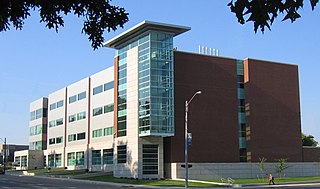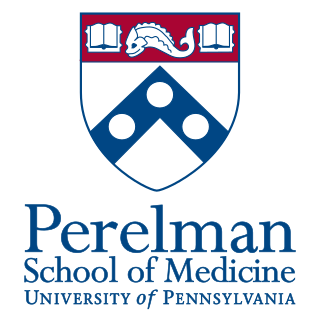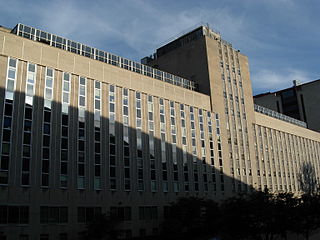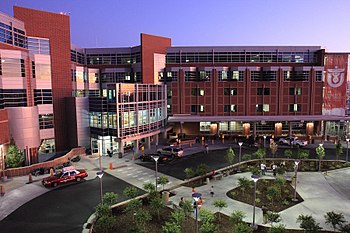
The Tulane University School of Medicine is located in New Orleans, Louisiana, United States and is a part of Tulane University. The school is located in the Medical District of the New Orleans Central Business District.

Balamurali Krishna "Bala" Ambati is an Indian-American ophthalmologist, educator, and researcher. On May 19, 1995, he entered the Guinness Book of World Records as the world's youngest doctor, at the age of 17 years, 294 days.

The Yale School of Medicine is the graduate medical school at Yale University, a private research university in New Haven, Connecticut. It was founded in 1810 as the Medical Institution of Yale College and formally opened in 1813.

The Temerty Faculty of Medicine is the medical school of the University of Toronto. Founded in 1843, the faculty is based in Downtown Toronto and is one of Canada's oldest institutions of medical studies, being known for the discovery of insulin, stem cells and the site of the first single and double lung transplants in the world.

The University of Tennessee Health Science Center (UTHSC) is a public medical school in Memphis, Tennessee. It includes the Colleges of Health Professions, Dentistry, Graduate Health Sciences, Medicine, Nursing, and Pharmacy. Since 1911, the University of Tennessee Health Science Center has educated nearly 57,000 health care professionals. As of 2010, U.S. News & World Report ranked the College of Pharmacy 17th among American pharmacy schools.

Mario Ramberg Capecchi is an Italian-born molecular geneticist and a co-awardee of the 2007 Nobel Prize in Physiology or Medicine for discovering a method to create mice in which a specific gene is turned off, known as knockout mice. He shared the prize with Martin Evans and Oliver Smithies. He is currently Distinguished Professor of Human Genetics and Biology at the University of Utah School of Medicine.

The Perelman School of Medicine, commonly known as Penn Med, is the medical school of the University of Pennsylvania, a private research university in Philadelphia, Pennsylvania. Founded in 1765, the Perelman School of Medicine is the oldest medical school in the United States and one of the seven Ivy League medical schools.
The University of Maryland School of Medicine, located in Baltimore City, Maryland, U.S., is the medical school of the University of Maryland, Baltimore and is affiliated with the University of Maryland Medical Center and Medical System. Established in 1807 as the College of Medicine of Maryland, it is the first public and the fifth oldest medical school in the United States. UMB SOM's campus includes Davidge Hall, which was built in 1812, and is the oldest building in continuous use for medical education in the Northern Hemisphere.


Oliver Smithies was a British-American geneticist and physical biochemist. He is known for introducing starch as a medium for gel electrophoresis in 1955, and for the discovery, simultaneously with Mario Capecchi and Martin Evans, of the technique of homologous recombination of transgenic DNA with genomic DNA, a much more reliable method of altering animal genomes than previously used, and the technique behind gene targeting and knockout mice. He received the Nobel Prize in Physiology or Medicine in 2007 for his genetics work.

Russ Biagio Altman is an American professor of bioengineering, genetics, medicine, and biomedical data science and past chairman of the bioengineering department at Stanford University.
Vanderbilt University School of Medicine is a graduate medical school of Vanderbilt University located in Nashville, Tennessee. Located in the Vanderbilt University Medical Center on the southeastern side of the Vanderbilt University campus, the School of Medicine claims several Nobel laureates in the field of medicine. Through the Vanderbilt Health Affiliated Network, VUSM is affiliated with over 60 hospitals and 5,000 clinicians across Tennessee and five neighboring states, managing more than 2 million patient visits each year. It is considered one of the largest academic medical centers in the United States and is the primary resource for specialty and primary care in hundreds of adult and pediatric specialties for patients throughout the Mid-South.
Imaging informatics, also known as radiology informatics or medical imaging informatics, is a subspecialty of biomedical informatics that aims to improve the efficiency, accuracy, usability and reliability of medical imaging services within the healthcare enterprise. It is devoted to the study of how information about and contained within medical images is retrieved, analyzed, enhanced, and exchanged throughout the medical enterprise.
Thaddeus P. Dryja is an American ophthalmologist and geneticist known for his role in the 1986 discovery of the Rb tumor suppressor gene. He was the David G. Cogan Professor of Ophthalmology at Harvard University and was the Global Head of Ophthalmology Research at Novartis. He was elected a member of the National Academy of Sciences in 1996.

The John A. Moran Eye Center at the University of Utah is an ophthalmology clinical care and research facility in the Mountain West.
Master of Medicine (MMed) is a postgraduate professional clinical degree awarded by medical schools to physicians following a period of instruction, supervised clinical rotations, and examination. The degree usually takes three years to complete, but may take up to four years in some countries. It is awarded by both surgical and medical subspecialties and usually includes a dissertation component. The degree may complement an existing fellowship in the chosen specialty or be the sole qualification necessary for registration as a specialist.
James J. "Jim" Cimino is an American physician-scientist and biomedical informatician. He is Professor of Medicine and Director of the Informatics Institute at the University of Alabama at Birmingham School of Medicine and Adjunct Professor of Biomedical Informatics at Columbia University. He is an elected fellow of the American College of Medical Informatics and a member of the National Academy of Medicine.
The West Virginia University School of Medicine is the professional school for the study of medicine and other health professions at West Virginia University in Morgantown, West Virginia. The medical school was established in 1902 as the first such institution in the state of West Virginia, and remains one of only three medical schools in the state.












